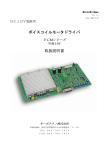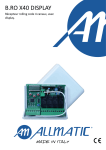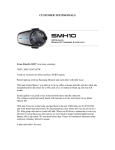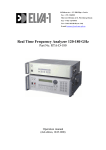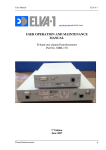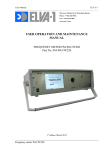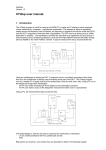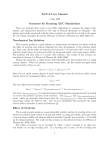Download 140 GHz Multichannel Interferometer - ELVA-1
Transcript
www.elva-1.com [email protected] Operation Manual Multichannel Interferometer 140 GHz for TCABR Tokamak operation manual (1st edition, 26.03.98) User Manual ELVA-1 1. GENERAL REMARKS Multichannel Interferometer is intended to be used for measurements of electron density of plasma in TCABR tokamak. It provides measurements is 3 channels simultaneously. Channels would be connected to 7 vertical chords. This is entire plasma diagnostics, that includes all needed components for density measurements. Output signals of the diagnostic would be stored by data acquisition system of the tokamak. 140 GHz Interferometer 1 User Manual ELVA-1 2. PRINCIPLES OF OPERATION 2.1 General description. The device based on the fact, that phase of millimeter wave signal passed through plasma depends on electron density averaged along the passing way. Interferometer measures phase of the signal and provides analog voltages for tokamak data acquisition system accordingly. Device consists of the following parts: 3 Transceivers of millimeter waves. Set of Oversized Waveguides. Two Vacuum Flanges with Built-in Antennas and Vacuum Windows. Signal Processing unit. Set of waveguide support elements, chord switches and waveguide high voltage isolators. Photo of the entire Interferometer assembled in laboratory conditions is presented on Fig.1. The device is designed to be installed into standard 19” rack. Rack is not included into the device. Assembled Multichannel Interferometer Oversized Waveguides 7.2x3.4 mm High Volatge Waveguide Isolators Vacuum Flanges for TCABR Tokamak with 7 antennas and Vacuum Windows Signal Processing Unit Flexible Waveguides for chords switching 3 Transceivers Waveguide support elements Fig.1 140 GHz Interferometer 2 User Manual ELVA-1 There are 3 independent channels designed using the same scheme. Heterodyne method of the receiving of the signal passed trough the plasma is used. That allows to achieve good sensitivity and large dynamic range of the device. The phase of passed signal is measured by the comparing with a phase of signal in reference channel built-in into each transceiver. Frequencies and output powers for Transmitters and Local Oscillators for 3 Transceivers are presented in table below: Table 1. Number of Channel 1 1 2 2 3 3 Module Frequency, GHz Transmitter Local Oscillator Transmitter Local Oscillator Transmitter Local Oscillator 139.0 139.018 140.0 140.018 140.842 140.860 Output Power, mW 20 12 17.9 16 21 12 There are two main advantages of the scheme which allows to make it more stable and reduce the problem connected with “phase jumps” - loosing of phase tracing. First one is a large dynamic range and sensitivity. The system operates properly up to -85 dB max attenuation between transmitter and receiver. 60 dB dynamic range is provided. It means that the device properly measure phase of millimeter wave signal passed through the plasma within attenuation range from 25dB up to -85 dB between transmitter and receiver. The second advantage is an increasing of the phase scale in 18 times. The system is linear within 18*(2Pi). It is able to recognize the phase jump on value up to 18*(2Pi). There is no loosing of phase within this scale. 2.2. One channel design. Block diagram of one channel is presented on the fig.2. All frequencies are indicated for channel No.2. The device consists of the following elements: Millimeter wave power Transmitter including Transistor DRO 7.777777 GHz Oscillator, Power amplifier with integrated 20 dB Directional Coupler, IMPATT Active frequency Multiplier x18. Output frequency of Transmitter is 140 GHz; Receiver including Transistor DRO 7.778777 GHz Oscillator, Power amplifier with integrated 20 dB Directional Coupler, IMPATT Active frequency Multiplier x18 and Balanced Mixer. Output frequency of LO is 140.018 GHz; 7 GHz Mixer for Reference channel; 18 MHz Pass Band Amplifier with Limiter Output; Frequency Divider F/18; Line Transceiver; Line Receiver and Signal Processing Unit (SPU); 140 GHz Interferometer 3 User Manual ELVA-1 Block Diagram of the Interferometer TRANSMITTER Transistor DRO 7.777777 GHz Power Amplifier with 20 dB Directional 800 mW Coupler Direct Channel Ψ1 IMPATT Active Frequency Multiplier x18 140 GHz 8 mW Coupled Channel (Ψ1) Ψ1 Ψ1-Ψ2 7 GHz Mixer 1 MHz Ψ1+∆Ψ(t) 8 mW Coupled Channel (Ψ2) Transistor DRO 7.778777 GHz 800 mW Power Amplifier Direct Channel with 20 dB Directional Coupler Ψ2 IMPATT Active Frequency Multiplier x18 140.018 GHz LOCAL OSCILLATOR Ψ2 Balanced Mixer with Low Noise 18 MHz Preamplifier (Ψ1-Ψ2)+∆Ψ(t) 1 18 ± 2 MHz Pass-Band Amplifier with Limiter Output 4 5 Reference Channel, 1MHz, Ψ1-Ψ2 Line Transceiver 2 (Ψ1-Ψ2)+∆Ψ(t)/18 Frequency Divider F/18 1 MHz Signal Channel, 1MHz, (Ψ1-Ψ2)+∆Ψ(t)/18 3 7 Line Receiver & Signal Processing Unit Saw-tooth voltage ADC Triggering pulses, 1MHz 6 Fig. 2 140 GHz Interferometer 4 User Manual ELVA-1 Transmitter and Local Oscillator in Receiver are built using the same scheme. Photo of Transmitter for channel No.3 is presented on Fig.3. Transmitter Module for Channel No.1 Transistor Power Amplifier Transistor DRO Power connector 1. +12 V 2. Ground for ±12 V 3. -12 V 4. +27V 5. Ground for +27V Current Stabiliser for Active Frequency Multiplier Voltage Stabiliser for DRO and Power Amplifier Isolator IMPATT Active Frequency Multiplier Waveguide Filter Output Flange 20 dB Directional Coupler output Fig. 3 To achieve good frequency stability the scheme with frequency multiplication is used. Transistor oscillator stabilized by Dielectric Resonator (DRO) is used as a stable frequency source with about 5*10-6 frequency stability. Difference between operating frequencies of DRO’s installed into transmitter and LO is 1 MHz. Signal of DRO is applied to input of Power Amplifier with 20 dB Directional Coupler on output. It amplifies DRO signal up to a level sufficient for the pumping of IMPATT Active Frequency Multiplier (AFM) - about 500mW…800mW. Waveguide isolator protects AFM against power reflection from a load. Waveguide filter selects 18th harmonic of pumping frequency. IMPATT Active Frequency Multiplier converts pumping signal into millimeter wave radiation. The radiation directed to plasma 140 GHz Interferometer 5 User Manual ELVA-1 through Oversized Waveguides. It is important, that phase of the signal produced by AFM is hardly defined by phase of the pumping signal. To avoid any influence of instability of sources the phase of the signal passed through plasma is compared with the phase of the reference one. Signals are compared on IF about 1MHz. Diagrams are presented on Fig. 5. For this aim signals from both DRO’s in transmitter and in LO modules are mixed on 7 GHz Mixer (see Block Diagram, Fig.2). The signals directed to the Mixer by means of Directional Coupler to decrease any influence of external measuring schemes to the frequency of DRO’s. Intermediate Frequency 1 MHz is obtained in reference channel. Bandwidth of 18 MHz IF Pass Band Amplifier with Limiter Output Amplification, dB 0 dB -3 dB 16 18 20 F, MHz Fig. 4 140 GHz Interferometer 6 User Manual ELVA-1 Signal Plots for 18 MHz Bandpass IF Amplifier with Limiter Output, Frequency Divider F/18 & Line Transceiver 1 18 MHz Preamplifier output (IFIN1 X3) 2 Amplifier with Limiter Output (pin 9 (8) DD7) 3 Line Transceiver Output 1 MHz (Signal Channel, pin 18 (16) DD4) 4 7 GHz Mixer output, Line Transceiver Reference input (REFI X5) 5 Line Transceiver Output 1 MHz (Reference Channel, pin 14 (12) DD4) Fig. 5 140 GHz Interferometer 7 User Manual ELVA-1 To obtain 1 MHz IF in the signal channel for comparing with the reference one the radiation passed through plasma mixes with LO signal on Balanced Mixer with Low Noise Preamplifier integrated. It is easy to see that IF is 18 MHz, taking into account 1 MHz frequency separation between DRO’s and x18 factor of frequency multiplication. Bandwidth of low noise preamplifier is significantly larger, then 18 MHz. Typical bandwidth of preamplifier used is 7 MHz-2.5 GHz. To reduce the noise the received signal is filtered within bandwidth 18MHz+/-2MHz (see Fig.4). Then it is amplified by logarithmic Pass-Band Amplifier with Limiter Output. Fixed amplitude signal with frequency 18 MHz (diagram No.2 on Fig.5) is directed to Frequency Divider F/18, that provides 1MHz signal for comparing with reference channel and so for phase measurements. This signal is directed to Line Transceiver (diagram No.3 on Fig.5). The bandwidth of filter 18+/-2MHz chosen as a compromise between speed of the system and sensitivity. To make the system faster it is needed to increase the bandwidth, because fast change of phase is equivalent to frequency shift. If this shift is larger then the bandwidth, signal will be lost, that leads to loosing of phase. On the other hand noise level depends on the bandwidth of the receiver. The application of heterodyne method allows to increase the bandwidth up to 4MHz which about 10 times higher then bandwidth normally used in homodyne schemes with the same sensitivity. 4 MHz bandwidth of the filter installed taking into account possible frequency shift of DRO due to temperature variations. Line Transceiver sends reference and measured signals (signal 3 and 5 on Fig. 5) to Signal Processing Unit that would be installed fare from tokamak. Twisted pair 5th category should be used to transmit these signals. It is important that transmission cable is isolated from Line Transceiver and Line Receiver by means of special transformers with low capacity between input and output. It is needed to decrease sensitivity of the system to surrounding electromagnetic noise. 2.3 Phase measurements. Therefore two signals from each channel of Interferometer are sent to Signal Processing Unit (SPU): reference signal and measured one. Both signals are square wave 1 MHz frequency and fixed amplitude. SPU measures difference is a phase between reference and measured signals. The difference depends on electron density of plasma. On a fig.2 it is marked as ∆Ψ(t). Scale of this phase is increased in 18 times after Frequency Divider F/18. The phase change on 360 degrees of the signal passed through plasma (point 1 on Fig. 2) corresponds 20 degrees phase change in output signal (point 3 on Fig. 2). That allows make the system “jump proved”, because fast jumps of the phase on the value less 18*(2Pi) not leads to phase loss. System is linear within 18*(2Pi) scale. Either 2*Pi jumps leads to the loss of phase in the scheme with not increased phase scale. For the presented scheme the phase loss would be only after the jump exceeds 18*(2Pi) value. Phase measurements are memorized in digital form using an external ADC. Signal Processing Unit provides input signals for ADC. It generates two signals: sawtooth voltage for ADC input and triggering pulses. As mentioned above, the principle of phase measurements based on the comparing of the phase of received signal with phase of the signal in reference channel. For this aim the saw-tooth voltage is produced (see fig. 6). Start of each tooth is triggered by a rise of a pulse taken from the reference channel, then the fall of each tooth is triggered by a fall of 4th pulse from reference channel countered from the “start triggering pulse”. As a result the 140 GHz Interferometer 8 User Manual ELVA-1 phase of saw-tooth voltage is hardly connected with the phase of reference channel. If one apply the saw-tooth voltage to an input of ADC and will use 1 MHz from signal channel for the triggering, digitized value will be proportional to the phase. The triggering of ADC should be provided by the fall of the triggering pulses. If all points measured by ADC at the triggering time one will put on a display, the picture like “zebra” will be obtained. Distance between ribs of “zebra” defines a scale of phase. The scale is 36*Pi in the presented scheme. Signal Diagrams for Line Transceiver and Signal Processing Unit Reference signal 1 MHz, CL1 t Blocking pulse, SWRES1 t Saw-tooth output voltage, SGN1 7 t Measured signal 1 MHz, IN1 6 t Triggering pulses, STR1 t Fig. 6 140 GHz Interferometer 9 User Manual ELVA-1 To avoid problems with triggering during tooth falling down time period, each first triggering pulse after 4-th reference pulse (it triggers the fall of each tooth) is removed (see Fig.6). It means that the triggering of ADC during the falling down period of the saw-tooth voltage is prohibited. Triggering pulses are shown on Fig.6 (signal No.6 on Fig.2) as well as saw-tooth voltage (signal No.7 on Fig.2). 3. EXPLOITATION CONDITIONS operations temperature: relative air humidity : primary power: atmospheric pressure: +10°…+40° C° up to 95% at the temperature 30° C° AC(220±22)V/(50±0.5)Hz 84-112 kPa. 4. SPECIFICATIONS 4.1 Transmitters 4.1.1 Operating frequency range and output power of transmitters: Number of Channel 1 2 3 Frequency, GHz 140.842 140.0 139.0 Output Power, mW 21 17.9 20 4.1.2 Frequency stability 5*10-6 4.1.3 Line width less then 1 kHz. 4.1.4 VSWR of output is no more than 1.25. 4.2 Receivers 4.2.1 Operating frequency range and output power of LO’s: Number of Channel 1 2 3 Frequency, GHz 140.860 140.018 139.018 Output Power, mW 12 16 12 4.2.2 Line width of LO’s less then 1 kHz. 4.2.3 Frequency stability of LO’s 5*10-6 4.2.4 Dynamic range of the receiver, i.e. variations of received signal is 60 dB min. 4.2.5 *Noise factor is < 13 dB. *measured for IF range 0.5-1.5 GHz 4.3 Entire Interferometer. 4.3.1 Time period of phase measurement repetition is 4 microseconds. 4.3.2 Accuracy of phase measurements +/-5 degrees. 4.3.3 Maximum attenuation between transmitter and receiver not less then 85 dB. 140 GHz Interferometer 10 User Manual ELVA-1 Number of Channel 1 2 3 Attenuation, dB 85 86 87 4.3.4 Maximum attenuation of the signal in plasma then the system still able to measure the phase, i.e. dynamic range of the entire system taking into account attenuation in oversized waveguides, vacuum windows, antennas coupling and insertion losses in all other elements between transmitter and receiver is not less then 20 dB: Number of Channel No. 1 Chord 141 GHz 1 32 dB 2 27 dB 3 27 dB 4 27 dB 5 30 dB 6 22 dB 7 29 dB Channel No. 2 140 GHz 40 dB 37 dB 30 dB 36 dB 34 dB 30 dB 34 dB Channel No. 3 139 GHz 40 dB 34 dB 35 dB 38 dB 34 dB 32 dB 38 dB 4.3.5 All parameters mentioned above are valid after 30 min warming-up period. 4.3.6 Power consumption is no more than 300 VA. 5. RELIABILITY 5.1. Main time to failure, no less than 5000 h. 5.2. 90% life time, no less than 2 years. 7. TECHNICUL DESCRIPTION 7.1 Transmitters and Local Oscillators Transmitter and Local Oscillator in Receiver are built using the same scheme. Photo of Transmitter for channel No.1 is presented on Fig.3. DRO and Power Amplifier can be repaired only on our factory, so electrical schemes are not presented in this manual. The following voltages and current consumption should be provided on Power connector (see Fig.3): Contact Voltage Current 1. 0.8 A max. +12 V ±0.5 V, 2. Ground for ±12 V 3. 100 mA max. -12 V ±0.5V, 4. 150 mA max. +27V ±0.5V, 5. Ground for +27V - 140 GHz Interferometer 11 User Manual ELVA-1 Both devices DRO and Power Amplifier use GaAs field transistors. Negative voltage applied to gate of the transistor limits drain current. If one apply positive voltage when the negative one is absent, transistors will be broken. It is important, that there is an alarm scheme in the stabilizer which protects the transistors against the wrong order of voltage application. Electronic scheme of voltage stabilizer for DRO and Power Amplifier is presented on the Fig.7. Numbers of contacts are indicated on the photo No. 8. Output positive voltage are regulated by means of transistor 2T819A2. It is installed under the card on metal base plate and don’t see on the photo. Positive polarity output is +7VDC. Resistors R1 and R2 would be installed to decrease output voltage to +5VDC…+6.5VDC for DRO. The value of resistor is adjusted on the factory. Electrical scheme for voltage stabilizer for DRO and Power Amplifier in Transmitter and LO modules. R1 12 R2 2T819A2 1 9 13 11 14 +12V 8k2 AOT 110A 2 7 6 3 1 8 4 5 0.68 2D212A 2 10 15 0.01 510 2k2 142EH3 910 100k 2C133A 150 3 KT816Б 5 -12V 4 110 200 6 7 0.68 KT203Б 1k 8 2D212A 1k2 KC139A Value of resistors R1 and R2 adjusted on the factory. Fig. 7 140 GHz Interferometer 12 User Manual ELVA-1 Voltage Stabilizer for DRO and Power Amplifier 15 (Ground) 14 12 (+7 VDC to Power Amplifier) 2 (Ground) 13 (+5…+6.5V to DRO) 1 (Input +12 VDC) 11 10 9 5 (-7V) 6 (-7V) 7 (-7V) 3 (Input -12VDC) 8 (Ground) 4 (Ground) Fig.8 When the negative voltage -12VDC isn’t applied, LED in AOT110A doesn’t light, so transistors are closed and IC 142EH3 closes output transistor 2T819A2. Diodes 2D212A protects the scheme against the wrong polarity application. Electronic scheme of Current Stabilizer for Active Frequency Multiplier is presented on Fig. 9. Photo of the stabilizer with indicated numbers of contacts is presented on Fig. 10. Electronic Scheme of Current Stabilizer for Active Frequency Multiplier KP142EH5B (7805) 1 1 +27VDC 3 3 30 22 2 Output 1.0 2 2D510A 4 Fig. 9 140 GHz Interferometer 13 User Manual ELVA-1 Current Stabilizer for Active Frequency Multiplier 2 1 IC of Stabilizer Variable Resistor for Current Adjustment 4 3 Active Frequency Multiplier Waveguide Isolator Fig. 10 140 GHz Interferometer 14 User Manual ELVA-1 7.2 Mixer The electrical scheme of mixer with preamplifier and diagram of connectors and flanges are presented on Fig. 11. Photo of the mixer is presented on Fig. 12. Balanced Mixer with Low Noise 18 MHz Preamplifier 18 MHz IF Output SMA Connector 4 RF Input Flange 1 Local Oscillator Flange 2 3 +5V Input SMA Connector Diagram of connectors and flanges (view from the side of SMA connectors. Numbers 1,2,3 and 4 are signed on the box of the Mixer. LO RF Input 18 MHz IF output 5kΩ 100Ω +5V Input Electronic scheme Fig. 11 140 GHz Interferometer 15 User Manual ELVA-1 Balanced Mixer with Preamplifier Fig. 12 140 GHz Interferometer 16 User Manual ELVA-1 7.3 18 MHz Pass-Band Amplifier with Limiter Output, Frequency Divider and Line Transceiver. These components are designed at a metal plate that has the same size as plate for LO or for Transmitter. Photo of the block (top view) is presented on the Fig. 14. Block of 18±2 MHz Pass-Band Amplifier with Limiter Output, Frequency Divider and Line Transceiver TR3 X2 18 MHz Pass-Band Amplifier with Limiter Output Bandpass Adjustment (C6) IF2 input (IFIN X3) TR 1 TR4 TR2 X1 X5 7 GHz Mixer X4 Frequency Divider: Line Tranciever Card Fig. 14 18 MHz IF signal from Low Noise Preamplifier comes to the input (pin 3 see Fig 13.) of the AD811 Operational Amplifier with 20 dB Gain. Inductor L1 and Capacitor C6 and load Resistor 50Ω forms the bandwidth of the amplifier. One can change the central frequency of the filter adjusting the C6 capacitor (see photo on Fig.14). Signal from the L1C6 resonance filter comes throw a Buffer Amplifier VT3 to BNC IF1 Control Plug, placed on the down panel of the Transmitter-Receiver Module, (X2 Fig.13) and to the input of the AD606 amplifier with Limiter Output. The AD606 (DD7 Fig.13) provides a hard-limited signal output (see plot 2 Fig.5) with phase stable within 3° over 70 dB of input signal amplitude variations. The amplifiers are installed into additional bras box (see Fig.14). Transformer TR1 and comparator AD9696 (DD1 Fig.13) converts the current signal from the AD606 differential open collector outputs (pins8 and 9 DD7) to TTL pulses. This 18 MHz pulses from the comparator (pin 8 DD1) comes to the input (pit 4, DD2) of the 18 times frequency divider made of the 74LS193 (Russian analog is 555IE7) counter (DD2) and 74LS74 (Russian-555TM2) D-Trigger (DD3). Two 140 GHz Interferometer 17 User Manual ELVA-1 elements (DD4.1 & DD4.2, signal part of Line Transceiver) of the 74LS244 used as a buffer amplifier and provide data transferring to the Signal Processing Unit, using Twisted Pair Cable. Available Length of the cable is 100 m. 1 MHz signal from 7 GHz Mixer comes to the input (X5 Fig.13) of the differential amplifier made of VT1 and VT2 transistors. Transformer TR2 and comparator AD9696KN (DD5 fig.13) converts the current signal from the Collectors of the Transistors to TTL pulses. DD4.4 and DD4.5 elements of 74LS244 chip (Russian analog 555AP5) are a reference part of Line Transceiver. Output plug of the Line Transceiver (X1 Fig.13) is placed on the down panel of the Transmitter-Receiver Module. TR3 and TR4 transformers are specially designed to provide very low capacity between input and output. Deposition of elements on Frequency Divider and Line Transceiver card is presented on Fig.14a. 7.4 Line Receiver And Signal Processing Module. This module is designed as a separate device Fig. 15. Power supply is integrated. It receives two 1 MHz signals from each Transmitter-Receiver Module. Input connectors are situated on the rear panel of LR&SP module. The wiring of the connectors are presented on Fig.16 together with photo of the rear panel. Photo of the front panel is presented on Fig.17. Line Receiver & Signal Processing Unit Fig. 15 140 GHz Interferometer 18 User Manual ELVA-1 The Rear Panel of Line Receiver & Signal Processing Unit GND Fuse Line Receiver input plugs 1. 2. 3. 4. REFH REFL SGHI SGLO 2 1 4 3 Fig. 16 Front Panel of the Line Receiver & Signal Processing Unit Power Indication Led Triggering Pulses for ADC Output plugs Power Switch Sawtooth Voltage Signal Output Plugs Fig. 17 140 GHz Interferometer 19 User Manual ELVA-1 Two 1 MHz signals from the Line Transceiver comes to the input plugs of the Line Receiver (plugs X1, X2, X3 Fig.16). Transformers TR1-TR6 and comparators DD1- DD6 converts the REF1-REF3 and SG1-SG3 current signals from the Twisted Pair Cable to TTL pulses: CL1-CL3 (reference channel) and IN1-IN3 (signal Channel). Signal Processing Chip (DD7) forms SWRES1-SWRES2 pulses for Sawtooth Generator control using CL1-CL3 and ADCWR1-ADSWR3 strobes for ADC triggering (plugs S1-S3 see Fig.18) using IN1-IN3. Sawtooth Generator is made of Current stabilizer (VT1, VD1, R1, R2 Fig.18), Capacitor C1, Operation Amplifier DD9 and Inverter with open collector output DD8. If an output transistor of the Inverter is closed (SWRES1=0), the stabilized current charge the C1 capacitor and voltage on the capacitor grows lineally. When SWRES1 signal becomes 1, then inverter connect positive plate of C1 to ground and discharge it. It forms the negative edge of the Sawtooth voltage. Charging current is determined by the value of the Sawtooth Amplitude Adjustment Resistors (see Fig.18) R2. Voltage Applied to the emitter of the VT1 transistor is stabilized using the VD1 reference. Adjusting the Value of R2 one can install the desired amplitude of the output Sawtooth Voltage. Sawtooth signal from the C1 capacitor comes through the buffer operational amplifier DD9 to the R1 Sawtooth Voltage Signal Output Plug (see Fig.18). Scheme of elements deposition on the card of Line Receiver And Signal Processing Module is presented on Fig.19. Photo of Module with removed upper cover is presented on Fig.20. Local power supply made of Transformer TR1, Diodes VD2 and VD3 and stabilizers 7805 and 7905 provide stabilized ±5 V voltages. Disposition of Elements & Blocks In the Line Receiver & Signal Processing Module Primary Power Transformer TR7 Sawtooth Amplitude Adjustment Resistors (channel No. 1; 2; 3) Sawtooth Voltage Generator (channel 3) Line Receiver Input Plugs Sawtooth Voltage Generator (channel 2) Local Power Stabilizer Sawtooth Voltage Generator (channel 1) Line Receiver Input Comparators Signal Processed Chip Line Receiver Input Transformers fig. 20 140 GHz Interferometer 20 User Manual ELVA-1 7.5 Power Supply for Transmitter-Receiver Module. The scheme of power supply is presented on Fig. 21, deposition of elements on Fig.22 and photo on Fig.23. Power Supply is installed under the plate of 18 MHz Pass-Band Amplifier with Limiter Output, Frequency Divider and Line Transceiver. Power supply is covered by metal plate for safety. Power Supply for Transmitter-Receiver Module Fig. 23 8. CONSTRUCTION 8.1 Transmitter-Receiver Modules Each Module consists of 4 plates installed one under another at “sandwich” manner. Plates are the following: 1. Transmitter, 2. LO with connected Mixer, 3. 18 MHz Pass-Band Amplifier with Limiter Output, Frequency Divider and Line Transceiver, 4. Power Supply The photo of the Module is presented on Fig. 24. The output of Transmitter is not viewed on the photo. Output vaweguides of LO and Transmitter is installed in opposite directions. 140 GHz Interferometer 21 User Manual ELVA-1 Three Modules are installed on the plate fitted to 19” rack according the picture presented on Fig. 1. Connection of input waveguides with Modules illustrated on Fig.25. Connection of input waveguides with Transmitter-Receiver Modules 2 mm RF Inputs Balanced Mixer 18 MHz IF Output +5V Power Input Primary Power Fuse 0.5 A Primary Power Cable Primary Power Switch +12V Power Indicator LED Red color Primary Power Indicator LED, Green color +12V Power Switch Fig. 25 140 GHz Interferometer 22 User Manual ELVA-1 There are two power switches are installed on each Module. One switch for negative voltage power supply and the second switch is for all other positive voltage power suppliers. The order of switching is important. The negative voltage should be switched on first and switched off last. Application of positive voltage is prohibited if negative voltage is absent. The problem is connected with GaAs field transistors (see article 7.1). There is an alarm system that protects the transistors against wrong order of voltage application, but it is better not use it too often. There is a possibility to measure plasma density along different chords of TCA tokamak. For this aim the peace of oversized waveguide connected to Transmitter or to Receiver made bent and. That make it flexible a bit. Two waveguide connectors (mechanical switches) are installed on the top and bottom of the rack with Transmitter-Receiver Modules. One of the connector is shown on Fig.26. Each Transmitter-Receiver Module would be connected with one of five waveguides. For this aim one should unscrew fixing plate and change the position of the waveguide connected with the Module. Tokamak flanges are supplied assembled. The vacuum test should be carried out before the installation to the tokamak. For this aim the flanges should be disassembled, cleaned and assembled again. Waveguide connector for the measurements in different tokamak chords Fig. 26 140 GHz Interferometer 23
























